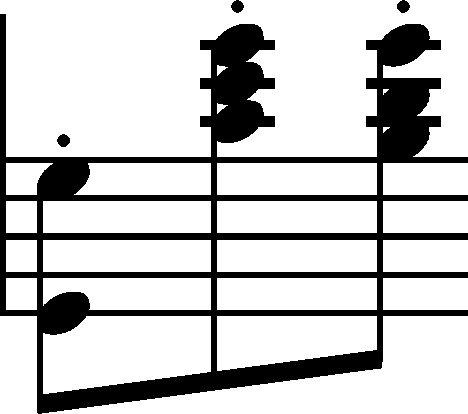




|
No pedalling in A |
|

|
||

|
||

|
Our suggestion |
|

|
Our alternative suggestion |
Pedalling of bars 1-2 and analog., same as the majority of pedal marks in the entire Etude, was added by Chopin in a proofreading of FE (→GE,EE). However, the indications are not precise – in bars 10, 13 and 54 the  marks are not accompanied with
marks are not accompanied with  marks in FE (→GE1→GE1a) (they were added in later GE,s and EE), while the indications in analogous bars differ in a way that may point to inaccuracy. It may have been a result of both the composer's and the engraver's haste. Taking into account this fact, in justified cases we suggest unified solutions in the main text.
marks in FE (→GE1→GE1a) (they were added in later GE,s and EE), while the indications in analogous bars differ in a way that may point to inaccuracy. It may have been a result of both the composer's and the engraver's haste. Taking into account this fact, in justified cases we suggest unified solutions in the main text.
In bars 1, 5 and analog. (6 places in total), the  mark in FE is only in bars 5 and 13, whereby only in bar 5 it is accompanied with a
mark in FE is only in bars 5 and 13, whereby only in bar 5 it is accompanied with a  mark. In GE and EE2 (→EE3)
mark. In GE and EE2 (→EE3)  was added in bar 13 and in EE4 pedalling in bar 53 was also added. In the main text, we leave bars 1, 9 and 49 without pedal marks, whereas in bars 13 and 53 we suggest to complete the indications. The difference may have been related to, e.g., the dynamics: bars 5, 13 and 53 are directly preceded with a crescendo, bars 1, 9 and 49 are not.
was added in bar 13 and in EE4 pedalling in bar 53 was also added. In the main text, we leave bars 1, 9 and 49 without pedal marks, whereas in bars 13 and 53 we suggest to complete the indications. The difference may have been related to, e.g., the dynamics: bars 5, 13 and 53 are directly preceded with a crescendo, bars 1, 9 and 49 are not.
In bars 2, 6 and analog. the indications appear in the sources in two variants (GE1a = GE):
| bar | FE, GE1 | EE, GE2-5 |
|---|---|---|
 |
 |
|
| 2 |   |
  |
| 6 |   |
  |
| 10 |  |
  |
| 14 |   |
  |
| 50 |   |
  |
| 54 |  |
  |
According to us, the bars, same as bars 1, 5 and analog., should be considered in two independent groups. In bars 2 and 50 the  marks are duly in the middle of the bar, so we may assume that Chopin thought of such pedalling also in bar 10. In turn, in bars 6 and 14 the marks are not compatible, hence each of the versions may be considered as justified:
marks are duly in the middle of the bar, so we may assume that Chopin thought of such pedalling also in bar 10. In turn, in bars 6 and 14 the marks are not compatible, hence each of the versions may be considered as justified:
 under the 3rd quaver in the bar corresponds to the majority of indications of the entire group of the bars;
under the 3rd quaver in the bar corresponds to the majority of indications of the entire group of the bars;  under the 2nd quaver appears in the first out of three places (bars 5-6, 13-14 and 53-54), in which pedal marks are written also in the previous bar (missing marks in bar 53 seem to be an oversight). Bars 5-6 are at the same time the only ones in which the pedalling is marked without a noticeable error (missing marks in bars 13 and 53-54), which makes it more reliable.
under the 2nd quaver appears in the first out of three places (bars 5-6, 13-14 and 53-54), in which pedal marks are written also in the previous bar (missing marks in bar 53 seem to be an oversight). Bars 5-6 are at the same time the only ones in which the pedalling is marked without a noticeable error (missing marks in bars 13 and 53-54), which makes it more reliable.
Compare the passage in the sources »
category imprint: Interpretations within context; Differences between sources; Corrections & alterations
issues: EE revisions, Inaccuracies in FE, GE revisions, Authentic corrections of FE, No pedal release mark
notation: Pedalling
